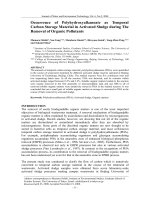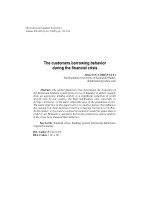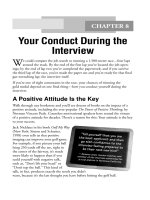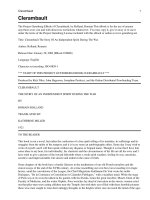During the meal
Bạn đang xem bản rút gọn của tài liệu. Xem và tải ngay bản đầy đủ của tài liệu tại đây (177.62 KB, 16 trang )
English for Tourism page 55
Unit 8
During the meal
SECTION 1
LANGUAGE FOCUS
1. Structures
Commenting
(Yes) This soup, stew…
steak
bread, fish
melon
…
is really delicious,
excellent…
tender
fresh
juicy, sweet
…
(Yes) These
These
mushrooms
rolls, shrimps
grapes
…
are really delicious…
fresh
juicy, sweet
…
I’m really/I sure am enjoying this soup/these rolls…
is
awful, disgusting, revolting,
This
soup, stew…
steak
bread
fish
milk
…
is burnt, underdone, overdone,
tough
stale, dry, old
off, not fresh
off, sour
bitter
tasteless
overcooked, undercooked
too salty/spicy/peppery/sweet
not spicy/sweet/…enough
(No)
These mushrooms… are awful … etc. (as above)
Responses
I’m very sorry, Sir/Madam.
Shall I take it/them away?
Would you like to order something else?
I’ll bring you another …/some other …
PRACTICE
1. Work in groups of three. Take turns to be A (the waiter or waitress) and B and C
(two customers). Write out a menu, or use an available menu (such as the one from
Saigon Palace), and imagine that the meal is in progress. Practice these exchanges:
A B and C A
(a) Is everything all
right, Sir/Madam?
(b) Would you like
some/a … to go with
your …
(c) Would you like
more/another …?
Ask for something
OR
Say you want something
OR
Express your enjoyment
OR
Complain
Respond
appropriately
2. Work in groups of three or four. One of you is a waiter/waitress, and the others are
customers. Imagine that you are having dinner at Saigon Palace Restaurant. Act out a
conversation between the waiter/waitress and the customers during the meal.
2. Vocabulary
Match the items and activities in the chart with the right number in the picture
opposite.
Number
5
----------
----------
----------
to carve
to flambé
to fillet
----------
----------
----------
----------
a silver flat
a vegetable dish
a sauce boat
a soup tureen
----------
----------
----------
----------
a trolley
a service counter
a sideboard
a hotplate
A customer who is enjoying a dish could use the words in column 1. Find words in
column 2 which mean approximately the opposite. For example: (a) – 3.
Column 1 Column 2
(a) delicious; excellent 1. sour
(b) tasty 2. dry
(c) juicy 3. awful, horrible, ghastly, revolting,
(d) fresh terrible
(e) tender (meat) 4. stale, old, off
(f) sweet (fruit) 5. tasteless
6. tough
English for Tourism page 56
English for Tourism page 57
SECTION 3
READING
1. Pre-reading
Discuss the answers to the following questions.
a. What should a waiter/waitress do when serving customers? What shouldn't
he/she do?
b. How is he/she supposed to carry plates, glassware and utensils when serving
guests?
c. What are some rules for service at the guest table?
2. Reading
SERVICE RULES
Service Rules
Every profession has rules, more or less. Table service has more. There are
personal rules dealing with you as an individual and rules for working directly
with guests. This should not scare you - in fact, the rules should make you feel
more secure. All these rules are based on common sense and are designed to make
your work easier.
Personal Rules
Gum chewing and smoking during working hours are forbidden. A noisy service
station is a sign that the service personnel are neglecting their main task, which is
creating a relaxing environment in which guests can enjoy their meals. All
utensils should be handled carefully and silently, and orders should be called
calmly, so that even during your busiest time, the atmosphere will not become
hectic. Collisions with colleagues are easily avoided if you obey the following
two rules:
1. Never stop abruptly.
2. In a restaurant, as on the road, there is right-hand traffic. Always keep to the
right.
Always move forward, never backward. You will soon learn that service is much
easier this way. Moreover, you will appear more graceful and elegant. Wasted motions
mean more work, and they are signs of inattentiveness. Always think about what you
are doing and plan ahead-make every move count. If you need a hand towel, carry it,
neatly folded, over your left forearm.
Carrying Plates, Glassware, Flatware, and Other Utensils
During service the right and left hands have distinct functions. The left hand carries
while the right hand works. Flatware, glasses, cups, and the like are always carried on
a tray, never in your hands. For safety and to prevent clattering, this tray should always
be covered with a paper or cloth napkin. When bringing platters to the side table or
guest table, always carry them with both hands. The hand towel should be draped
lengthwise over the cloche so you can hold the platter on both ends. If several plates or
serving dishes are carried at the same time, place them on the towel so they will not
English for Tourism page 58
slide. Serving bowls and sauce boats are always placed on a small plate with a paper
doily.
The Carrying of Plates
A Stack of Plates
A stack of plates is always carried with both hands. Wrap your hand towel around the
plates so that you do not touch the plates with your bare hands. Do not hold the plates
against your body.
One Plate
Always hold a plate between the thumb and index finger. Your thumb should be flat on
the rim of the plate, pointing toward the rim, never into the plate. Hold the first plate
between the thumb and index finger. The index finger is placed slightly behind the lower
rim. Slide the second plate against the index finger and support it with the other fingers
from beneath.
Two Plates, Held from Above
The first plate is held with the thumb and index finger. With that hand turned slightly
upward, balance the second plate on the lower forearm and the ball of the thumb. Support
the upper plate with the other fingers.
The Clearing of Plates
The basic technique is the same as carrying two plates from above. After picking
up the first plate, arrange the flatware on it. The handle of the first fork is under
your thumb; this will secure the remaining flatware. Then slide the knife in at a
right angle under the fork. Now pick up the second plate with the flatware, and
place the flatware on the first plate, fork beneath the thumb and knife below. The
remaining plates are stacked on the second plate, while the flatware is arranged on
the first plate. In an elegant service no more than four plates are cleared at once.
Small food remnants on the plates can be pushed to the lower plate; be sure to
turn away from the guest when doing this. When the plates contain a lot of
leftovers, they must be scraped away from the table. Clear only two plates at a
time and sort in the waiters' pantry.
Rules for Service at the Guest Table
Women are usually served first. If it is an honorary dinner, of course, the guest of
honor is served first. Otherwise, age and status of the guest determine the
sequence, with older or more distinguished guests served first. The host is always
served after his or her guests. When children are present at the table, serve them
as quickly as possible to maintain peace.
Decide whether the following statements are true (T) or false (F).
a. ________ These rules make employees more secure when delivering their
services.
b. ________Noisy employees create a relaxing environment where guests are
enjoying their meals.
c. ________ When delivering service employees have to use both the right and
left hands for the same purpose such as carrying plates or cleaning leftovers.
English for Tourism page 59
d. ________There must be paper or a napkin on a tray in order to prevent
clattering from plates and glassware.
e. ________ Waiters/Waitresses can use their fingers to touch plates if they
always bring a towel with them.
f. ________When holding a plate, waiters/waitress must place their thumbs on the
rim of the plate and never put it into the middle of it.
g. ________When there are leftovers on a plate, waiters/waitresses must let them
sit there until customers ask them to clean.
h. ________ Children should be served quickly because they may cause a fight if
served late.
3. Vocabulary
Fill in the blanks with NO MORE THAN three words taken from the text.
Table service rules deal with both ________ practices and rules that employees have
to take into account when working with ________. Despite appearing quite scary to
some newly trained employees, these rules help service workers work more effectively
and ________.
The first rule, which is about ________, emphasizes the attention employees are
supposed to pay to when serving customers. They are required to ________ what they
intend to do with their ________. The ________ and ________ hand rule is
recommended while they are ________ plates, glassware and utensils. Employees are
requested to handle everything with their ________, especially with their thumb and
________. ________ are served first if it is an honorary occasion. The other factors
such as ________ and ________ are also considered at the guest table.
4. Speaking
Now discuss the following questions with your friends.
a. What are other useful rules that you can add to the text?
b. Do these rules make you feel more secure or less confident to deliver service at
the guest table?
c. Have you ever observed these rules being applied in a Vietnamese restaurant?
Comment on your experience.
English for Tourism page 60
SECTION 3
DO YOU REMEMBER?
1. What may customers say to comment? How do you response?
...........................................................................................................................................
...........................................................................................................................................
...........................................................................................................................................
...........................................................................................................................................
...........................................................................................................................................
...........................................................................................................................................
...........................................................................................................................................
...........................................................................................................................................
...........................................................................................................................................
...........................................................................................................................................
...........................................................................................................................................
...........................................................................................................................................









